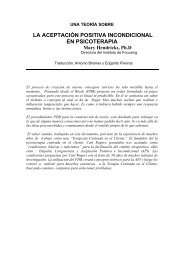8 Focusing en de experiëntiële aspecten van psychotherapie
8 Focusing en de experiëntiële aspecten van psychotherapie
8 Focusing en de experiëntiële aspecten van psychotherapie
Create successful ePaper yourself
Turn your PDF publications into a flip-book with our unique Google optimized e-Paper software.
614 Literatuur<br />
Krips, F.A. (1996). Korte gedacht<strong>en</strong>: kortdur<strong>en</strong><strong>de</strong> cliëntgerichte <strong>psychotherapie</strong>. Tijdschrift Cliëntgerich-<br />
te Psychotherapie, 34(4), 50-59.<br />
Kriz, J. (2001). Self-organization of cognitive and interactional processes. In M. Matthies, H. Malchow<br />
& J. Kriz (Red.), Integrative systems approaches to natural and social dynamics (pp. 517-537). Hei<strong>de</strong>lberg:<br />
Springer.<br />
Kriz, J. (2004). Personz<strong>en</strong>trierte Systemtheorie. Grundfrag<strong>en</strong> und Kernaspekte. In A. von Schlippe &<br />
W.C. Kriz (Red.), Personz<strong>en</strong>trierung und Systemtheorie. Perspektiv<strong>en</strong> für psychotherapeutisches Han<strong>de</strong>ln<br />
(pp. 13-67). Götting<strong>en</strong>: Vand<strong>en</strong>hoeck & Ruprecht.<br />
Kriz, J. (2006). Self-actualization. Nor<strong>de</strong>rstedt: Books on Demand GmbH.<br />
Kriz, J. (2007). Actualizing T<strong>en</strong>d<strong>en</strong>cy: The link betwe<strong>en</strong> person-c<strong>en</strong>tered and experi<strong>en</strong>tial psychotherapy<br />
and interdisciplinary systems theory. Person-C<strong>en</strong>tered & Experi<strong>en</strong>tial Psychotherapies, 6, 30-44.<br />
Kriz, J., & Slunecko, T. (Red.). (2007). Gesprächs<strong>psychotherapie</strong>. Die therapeutische Vielfalt <strong>de</strong>s personz<strong>en</strong>triert<strong>en</strong><br />
Ansatzes. Wi<strong>en</strong>: UTB. Facultas.wuv.<br />
Kwaliteitsinstituut voor <strong>de</strong> Gezondheidszorg CBO (2003). Richtlijn inzake <strong>de</strong> behan<strong>de</strong>ling <strong>van</strong> angststoorniss<strong>en</strong>.<br />
Utrecht: CBO.<br />
Kwaliteitsinstituut voor <strong>de</strong> Gezondheidszorg CBO (2005). Richtlijn inzake <strong>de</strong> behan<strong>de</strong>ling <strong>van</strong> <strong>de</strong>pressie.<br />
Utrecht: CBO.<br />
Lago, C., & MacMillan, M.(1999). Experi<strong>en</strong>ces in relatedness. Group work and the person-c<strong>en</strong>tred<br />
approach.. Ross-on-Wye, UK: PCCS Books.<br />
Lambers, E. (2006). Supervising the humanity of the therapist. Person-c<strong>en</strong>tered & Experi<strong>en</strong>tial Psychotherapies,<br />
5, 266-276.<br />
Lambert, M.J., & Barley, D.E. (2002). Research summary on the therapeutic relationship and psychotherapy<br />
outcome. In J.C. Norcross (Red.), Psychotherapy relationships that work (pp. 17-32). New<br />
York: Oxford University Press.<br />
Lambert, M.J., Dejulio, S.J. & Stein, D.M. (1978). Therapist interpersonal skills: Process, outcome, methodological<br />
consi<strong>de</strong>rations, and recomm<strong>en</strong>dations for future research. Psychological Bulletin, 85,<br />
467-489.<br />
Lambert, M.J., & Ogles, B.M. (2004). The efficacy and effectiv<strong>en</strong>ess of psychotherapy. In M.J. Lambert<br />
(Red.), Bergin and Garfield’s handbook of psychotherapy and behavior change (5th ed., pp. 139-193).<br />
New York: Wiley.<br />
Lambrechts, G. (2003). De Gestalttherapie tuss<strong>en</strong> to<strong>en</strong> <strong>en</strong> straks. Berchem: Epo.<br />
Landreth, G.L. (2002). Play therapy: The art of the relationship (2nd ed.). New York: Brunner-Routledge.<br />
Landreth, G.L., & Bratton, S. (2006). Child Par<strong>en</strong>t Relationship Therapy (CPRT): A 10-Session Filial Therapy<br />
Mo<strong>de</strong>l. New York: Routledge Publishers of Taylor & Francis Publishing.<br />
Landreth, G.L., Homeyer, L., Glover, G., & Swe<strong>en</strong>ey, D. (1996). Play therapy interv<strong>en</strong>tions with childr<strong>en</strong>‘s<br />
problems. Northvale, NJ: Jason Aronson.<br />
Landreth, G.L., & Lobaugh, A. F. (1998). Filial therapy with incarcerated fathers: Effects on par<strong>en</strong>tal<br />
acceptance of child, par<strong>en</strong>tal stress, and child adjustm<strong>en</strong>t. Journal of Counseling and Developm<strong>en</strong>t,<br />
76, 157-165.<br />
Lasui, C. (1988). Gevoel<strong>en</strong>s <strong>en</strong> verwachting<strong>en</strong> <strong>van</strong> cliënt<strong>en</strong> <strong>en</strong> therapeut<strong>en</strong> voor e<strong>en</strong> therapeutische sessie.<br />
E<strong>en</strong> empirische bijdrage. Niet-gepubliceer<strong>de</strong> lic<strong>en</strong>tiaatsverhan<strong>de</strong>ling, K.U. Leuv<strong>en</strong>.<br />
Laub, D., & Auerhahn, N. (1993). Knowing and not knowing. International Journal of Psychoanalysis, 74,<br />
287-302.<br />
Lauteslager, M. (2006). Het evid<strong>en</strong>ce-beest heeft kur<strong>en</strong>. Gebruik <strong>en</strong> misbruik <strong>van</strong> EBP, RCT- <strong>en</strong> ESTmethodologie.<br />
Tijdschrift voor Psychotherapie, 32, 347-366.










